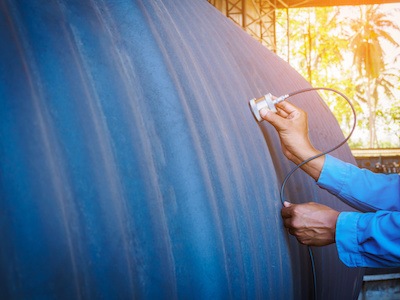Ultrasonic testing (UT) is a valuable type of Non-destructive Testing (NDT) method that provides a reliable picture of the condition of critical industrial parts.
Ultrasonic testing may not provide a complete picture of the condition of the part due to some limitations, but this type of NDT is highly reliable to establish a baseline understanding of the part’s condition.
The main reasons to use ultrasonic testing are to obtain measurements, evaluate the presence of flaws or cracks in a part, and determine the material make-up of the part.
How Ultrasonic Testing Works
Ultrasonic testing uses high-frequency sound waves to send signals back and forth within the part to take measurements, perform evaluations, and make determinations.
1. Ultrasonic Testing for Measurement
Ultrasonic testing uses a device that includes a transducer (placed on the surface of the part), a pulser/receiver that receives information about the waves traveling through the part, and the display that presents the measurement.
As the waves travel through the part, the pulser/receiver uses time to determine when the signal was sent and when the echo was received to calculate dimensions. The dimensions are presented on the display.
2. Ultrasonic Testing for Evaluation
The sound waves that are sent through the part may also provide information on the presence of deformities, cracks, or other irregularities that affect the integrity of the part.
When a deformity, crack, or other irregularity “interferes” with the sound waves, a signal is sent back to the transducer and the information is presented on the display. The test can be performed multiple times to ensure accurate read-outs in order to pinpoint the location of the issue that needs to be addressed.
3. Ultrasonic Testing for Determination
Ultrasonic testing can also be used to determine the material make-up of the industrial part. This is important to know what type of protective coating or finishing treatment is best to apply to the part.
How does this work? Different material has different thickness and composition, which produces different sound waves. When the transducer is applied to the surface, ultrasonic testing can help determine the composition of the part by analyzing the sound waves produced beneath the surface.
Consider Ultrasonic Testing for Preliminary Evaluation of the Part
Obtaining measurements, locating cracks or deformities, and determining the material composition of an industrial part are important steps to maintain the integrity of an industrial part.
Ultrasonic testing can provide this preliminary information to help make an informed decision about next steps to protect or treat the part. However, UT does have its limitations in that some surfaces are difficult to analyze using sound waves or some parts are simply not accessible to directly perform the test.
Superior Shot Peening & Coatings can help determine the best NDT option for your critical parts. We also offer an in-house NDT facility to perform tests on critical parts. If your parts cannot be moved and sent to our facility, our mobile team can perform NDT tests on-site at your location.
Contact us today to inquire about utilizing our NDT testing capabilities to maintain the integrity of your critical parts.

